In this difficult time where climate deniers are both in and outside of the federal administration, it can be easy to feel hopeless. But these three men show the power of an individual to make a change in the world. With the environment suffering at the hands of climate change, let these stories inspire you.
Jadev “Molai” Payeng: The man who built the forest

Forest Man
Jadev Payeng has dedicated his life to bringing back the forests of India and creating wildlife refuges. As a teengaer more than 30 years ago, Payeng planted along sandbanks as a starting point before he became known for bringing back 1,360 acres of dense jungle.
The turning point for Payeng was when he saw a large number of snakes washed up on the shore of a sandbank in 1979: “The snakes died in the heat, without any tree cover. I sat down and wept over their lifeless forms. It was carnage. I alerted the forest department and asked them if they could grow trees there. They said nothing would grow there. Instead, they asked me to try growing bamboo. It was painful, but I did it. There was nobody to help me. Nobody was interested,” says Payeng, now 47.
Working alone, Jadev brought the trees back to a barren wasteland. Once there was cover and shelter for the animals, he worked on bringing back ecological balance to the forest. He brought animals back to this newly flourishing environment now called the Molai woods. He has even created territory for animals facing extinction due to habitat loss like rhinos, tigers, and elephants.
If you’d like to know more about his story, the film Forest Man covers Jadev’s amazing journey of forest restoration
“Payeng has already shown the example that if one person can, at his own effort, can do this kind of plantation than why not others? If we can have economic value, if it is economically viable, if it gives benefit to the people, if we can plan it in this way, then we can do it for the entire catchment.” – Forest Man 12:18
Tim Wong: The man who saved the butterflies

The Butterfly Whisperer
The California Pipevine Swallowtail is a blue glittering butterfly that was suffering at the hands of urbanization in San Francisco. Facing a steady decline in the 19th and 20th century, they became an infrequent sight in San Francisco despite having inhabited the city for centuries. The only food that these butterflies eat, a deciduous vine called pipevine, was becoming increasingly rare across its native region.
Tim Wong helped put a stop to that by collecting pipevine cuttings from the San Francisco Botanical Gardens and making his own backyard butterfly sanctuary. This sheltered space was covered from predators while mimicking their natural habitat. Here he could study the caterpillars that he collected and learn about the Pipevine Swallowtail species. By successfully breeding the adults who matured in his garden sanctuary, he was able to transfer hundreds of their offspring back into nature and the Botanical Gardens in Golden Gate Park.
Hundreds of butterflies were beginning to thrive and return to their natural life cycles. Tim Wong has been praised for his hard work and his triumph shows that anyone with determination and a dream can make some positive change in the world.
Yacouba Sawadogo: The man who stopped the desert

The Man Who Stopped the Desert
The desert of Yacouba’s homeland in Burkina Faso was spreading. The poor soil conditions came from years of over-farming, over-grazing, and overpopulation which took its toll on the land. The land began to erode and dry out at a startling rate. People had tried to help stop the process, but the desert was advancing and worsening. This is when Yacouba took matters into his own hands.
In 1980, Yacouba began his seemingly unusual method for bringing back the forest. Using an ancient African farming method called “zai,” he began to refresh the land. Zai is the process of digging small holes in the ground which are filled with compost. The seeds are planted in the compost and the holes in the hard ground are filled up with water during the rainy season; they aren’t as quickly drying in the dry season. He dug his holes during the dry season, so when the rain came the seeds were ready. Using this method, he brought back a 30-acre forest in 20 years.
This method not only brought back trees but also helped bring nutrition back into the soil and stop the harsh erosion of the desert. Yacouba spreads his teachings to any who would like to learn them, so that everyone can have the chance to bring fertile lands back into their communities.
Yacouba was the focus of a 2010 documentary called The Man Who Stopped the Desert and he’s still spreading his techniques hoping to bring back the forests.
Yacouba, Tim, and Jadev’s hard work and dedication show that anyone who uses their hearts and minds can make a difference. Individuals like you are bringing positive change into their communities, and they have the power to help change the world.
- 21 Pictures That Will Restore Your Faith In Humanity ›
- 35 Heartwarming Photos That Will Restore Your Faith in Humanity … ›
- 20+ Photos That Will Restore Your Faith In Humanity | Bored Panda ›
- Heartwarming tales that will restore your faith in humanity ›
- 17 Photos That Will Restore Your Faith in Humanity ›





